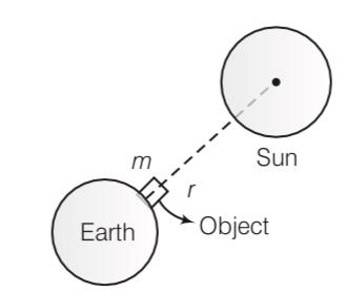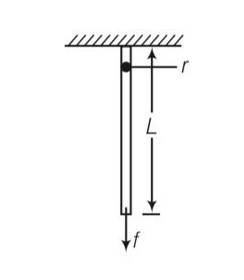physics ncert solutions class 11th
Get insights from 952 questions on physics ncert solutions class 11th, answered by students, alumni, and experts. You may also ask and answer any question you like about physics ncert solutions class 11th
Follow Ask QuestionQuestions
Discussions
Active Users
Followers
New answer posted
4 months agoContributor-Level 10
This is a Multiple Choice Questions as classified in NCERT Exemplar
Answer-c, d
Explanation- Gravitation force F= where M is mass of sun and m is mass of earth.
When G decrease force will also decrease so according to this it will not in the fixed circular orbits around the sun. as when radius increases the force will decreases and soon earth leave the solar system.
New answer posted
4 months agoContributor-Level 10
This is a Multiple Choice Questions as classified in NCERT Exemplar
Answer-a, c, d
Explanation-due to the huge amount of charges on the sun and the earth electrostatics force of attraction will be large. Gravitational force is also attractive in nature have both forces will be added and obeys kepler's law also.
New answer posted
4 months agoContributor-Level 10
This is a Multiple Choice Questions as classified in NCERT Exemplar
Answer-a, c, d
Explanation- G'=10G
Consider the diagram

Force on the objects due to the earth =
= (10g)m= 10mg
Force on the objects due to the sun F=
As r>>R so F will be very small
So effect of sun will be neglected
Now g'=10g
Hence weight of person =10mg
So gravity pull on the person will increase, due to it walking on ground would be more difficult
Critical velocity Vc is proportional to g
So Vc
V'>g
Vc'>Vc hence rain will fall faster. To overcome the increased gravitational force of the earth the aeroplane will have to travel much faster.
New answer posted
4 months agoContributor-Level 10
This is a short answer type question as classified in NCERT Exemplar
Bulk modulus of rubber is 9.8*108 N/m2
density of sea water is 103 kg m-3
percentage decrease in volume
Let the rubber ball be taken up to depth h.
Change in pressure =h g
Bulk modulus K=
So h =
New answer posted
4 months agoContributor-Level 10
This is a short answer type question as classified in NCERT Exemplar
Young's modulus of steel Y= 2
Coefficient of thermal expansion = 10-5
Length =1m
Area = 10-4m2
Increase in temperature t= 2000C
Tension produced in steel rod F = YA =2
= 4
New answer posted
4 months agoContributor-Level 10
This is a short answer type question as classified in NCERT Exemplar
Young's modulus Y=
For first wire Y=

For second wire Y=
From above equations
So l=l' hence Y will also same.
New answer posted
4 months agoContributor-Level 10
This is a short answer type question as classified in NCERT Exemplar
Young's modulus Y=
For a perfectly rigid body change in length
Y= so young's modulus for perfectly rigid body is infinite
New answer posted
4 months agoContributor-Level 10
This is a short answer type question as classified in NCERT Exemplar
Work done =1/2F l
As spring of both are equally compressed
So Young's modulus Y= as is inversely proportional to young's modulus
And also we know W is inversely proportional to young's modulus
So
Wsteel
New answer posted
4 months agoContributor-Level 10
This is a short answer type question as classified in NCERT Exemplar
stress=
Therefore stress is scalar quantity not vector quantity.
New answer posted
4 months agoContributor-Level 10
This is a short answer type question as classified in NCERT Exemplar
Young's modulus Y= stress/longitudinal strain
For same longitudinal strain,
Ysteel>Yrubber
so we can say that stresssteel > stressrubber
Taking an Exam? Selecting a College?
Get authentic answers from experts, students and alumni that you won't find anywhere else
Sign Up on ShikshaOn Shiksha, get access to
- 65k Colleges
- 1.2k Exams
- 686k Reviews
- 1800k Answers
